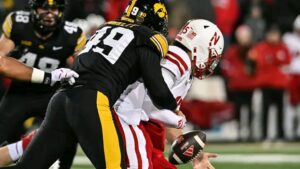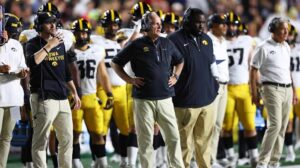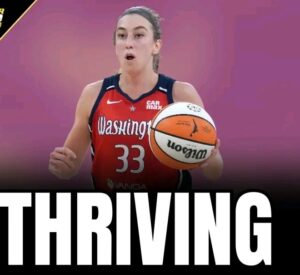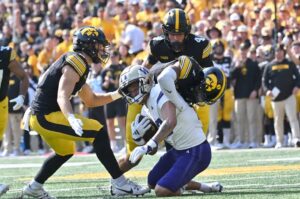
The $100 Billion Error: How Corporate Fear Forced Nike to Undercut the Caitlin Clark Era and Give the Spotlight to a Ball Company.
A single, well-timed story can be worth billions in the fiercely competitive world of sports marketing. For many years, Nike, the undeniable titan of sportswear, thought it had won the big prize: Caitlin Clark, a generational superstar whose impact would revitalize their brand and revolutionize women’s basketball. Given her seismic impact on ticket sales, viewership, and culture, her 8-year, $28 million contract already looked like one of the best deals in corporate history.
However, in a startling twist of events that has rocked the industry, the masterstroke was actually performed by an unlikely rival—Wilson, the company that makes the ball—rather than Nike. Recently, Wilson released a commercial with Clark that is so emotionally impactful and well-balanced that it has caused corporate panic among Nike executives. A painful, public indictment of Nike’s strategic paralysis, this exposes a deeper rot where fear and politics have tragically outweighed boldness and vision. It’s not just about a good ad.
One must first comprehend the fragile state of Nike’s kingdom in order to appreciate the gravity of its error. With a market value of over $200 billion, the multinational sportswear behemoth has been dealing with a protracted crisis that has damaged its stock and reputation. The company’s value has dropped by more than $100 billion since 2021. Investors’ outrage escalated to the point where the CEO resigned, a glaring indication of their long-standing discontent with the company’s course. Nike continued to falter, failing to find the product line or the narrative required for a clear comeback, while competitors like Adidas were able to establish a firm footing even after significant partnership disruptions.
According to financial analysts, revenue will drop by 11.5% in the current quarter, which is the steepest decline since the 2020 pandemic’s initial shock. Though industry experts are clear that dazzling new designs alone won’t solve this crisis, Nike’s leadership promised a comeback. The business urgently needs a brand-new, multibillion-dollar product pillar, which is a huge undertaking that usually takes years to develop.
That revival was supposed to be accelerated by Caitlin Clark. According to the transcript, she was “a generational athlete, twice as well known as Angel Reese and four times more popular than any male college star.” She was courted by every major brand, including Curry’s label, Under Armour, and Adidas. By selecting Nike, she trusted the company that had contributed to the development of her college legacy with her fledgling professional image. The basketball community eagerly anticipated her first signature shoe, which was meant to mark the beginning of a new era of female dominance in sports.
The Unforgivable Delay: Sacrificing Speed for Close Examination Nike made its deadly strategic blunder here. The company shocked both fans and analysts by revealing that Clark’s signature shoe would not be released until 2026 or even 2027, despite having signed the WNBA’s most marketable player. This meant waiting two to three years for a product that would sell out and bring in billions of dollars right away.
Nike’s history of fearless execution contrasts sharply and painfully with this hesitation. They were so keen to secure LeBron James’ future when they courted him in 2003 that they started designing his sneakers before he had even signed a contract. Within three months, the shoes were created and delivered to the court under the code name “Air Zoom Generation,” ready for his very first NBA game. Bold, decisive, and totally dedicated to its superstars, that was Nike at its best.
Today, a crushing, self-imposed delay has taken the place of that speed. A clear sign that Nike is fundamentally flawed is the company’s regression from a three-month design cycle to a three-year wait. Nike demonstrated that it was immobilized by fear by putting Ya Wilson’s shoe out first and delaying Clark’s shoe indefinitely. This fear included fear of criticism, fear of controversy, and fear of participating in the very discussion that Clark’s immense popularity sparked.
Corporate Politics’ Paralyzing Influence Nike’s issue was that, instead of focusing on Clark’s indisputable commercial appeal and brilliance, they let outside noise and political discourse control the story. Critics rushed to argue whether Clark “deserved” a signature shoe before other well-known WNBA players as soon as she signed her contract. A significant flashpoint was also created by the controversy surrounding the Team USA Olympic roster snub. The official justification, which contradicts history, was that Clark hadn’t “earned it yet.”
Twenty years later, Diana Taurasi joined the 2004 Olympic team as a rookie with statistics almost exactly the same as Clark’s, and Christian Laettner made the 1992 Dream Team without playing a single NBA minute. The Team USA selection committee later acknowledged that Clark’s exclusion was a mistake, but it also demonstrated the tremendous political pressure on her career.


The transcript emphasizes Nike’s decision to keep quiet rather than firmly supporting their investment. They couldn’t handle the social criticism and controversy because they were “paralyzed by fear and politics.” The main reason for the delay is this fear. It appears that the company was so afraid of public criticism that they squandered the greatest marketing opportunity in women’s basketball history by putting a cautious, committee-approved strategy ahead of the crucial, daring nature of iconic branding.
Wilson’s Masterclass: The Key to the Game Is Authenticity Wilson took advantage of Nike’s indecision with an advertisement that was a masterwork of narrative. Clark signed a historic contract with Wilson, a company that Nike probably never saw as a serious threat. This made Clark the first woman to ever own a Wilson basketball and the only athlete since Michael Jordan to do so.
The ad’s power came from its straightforward, unadulterated authenticity. The opening line, “When you strip away the noise and the bright lights, it’s just the game you loved as a kid,” struck a chord with every basketball fan. This message was a silent, devastating critique of Nike’s cautious strategy. Wilson capitalized on the unadulterated, sentimental feeling of basketball love, passion, and the purity of the game itself, while Nike falters in its attempts to appease all demographics and steer clear of any controversy. The campaign, which ended with the memorable and impactful tagline, “Caitlin always basketball,” was praised as one of the best basketball advertisements in recent memory.
Wilson demonstrated that three factors—talent, authenticity, and emotion—are crucial for success in contemporary sports branding. They researched Clark’s character, interests, and relationship to the sport in order to create a message that accurately captured who she was. The fans noticed that they were concentrating on the sport rather than politics. Wilson asserted the moral superiority and the core of the game by using basketballs to tell the tale that Nike was too scared to tell with sneakers.
For Nike, the irony is harsh. This company’s entire global empire was founded on the brave icons of LeBron James, Tiger Woods, and Michael Jordan—athletes who not only dominated their respective sports but also revolutionized culture. Caitlin Clark has the same irresistible cultural significance and magnetic spark. However, Nike has viewed her as a risk that needs to be carefully managed rather than as an icon to be boldly celebrated.
Long after the stock market swings, the effects of this choice will be felt. Wilson is now able to establish a lasting relationship with Clark that is founded on respect and genuineness because of Nike’s hesitancy. In a world where customers expect transparency and real passion from the businesses they support, they have harmed their own brand credibility by letting a rival shape the story of their biggest star.
Nike sacrifices more brand loyalty the longer they are mired in internal politics and damage control. They paid a low price to lock Clark in, but now they are paying the ultimate price: the story’s demise. Nike needs to wake up and see that their approach is cowardly rather than bold. They run the risk of losing out on billions of dollars in potential revenue as well as their last, best opportunity to reestablish themselves at the top of sports culture if they do not instantly change course and give Clark their whole attention with the speed and vision of their Jordan and James eras. Wilson just demonstrated to the basketball community that a challenger is prepared to take over a game when a titan blinks





